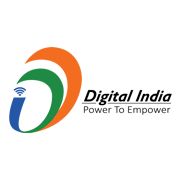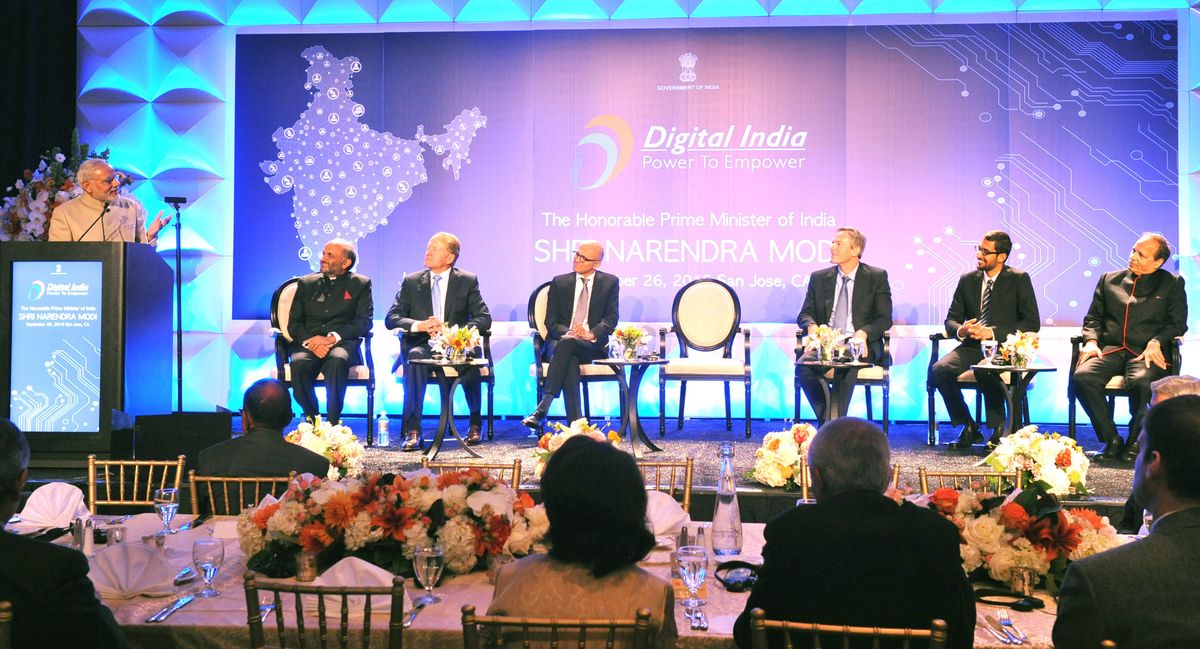
Every government has an initiative or project that becomes
symbolic to the government’s image and is often treated as the report card to
scale its progress. Digital India is that emblematic program of the reigning
Prime Minister Narendra Modi.
Prime Minister Narendra Modi launched Digital India Program
on 1 July 2015 with a view to empower citizens of India with the digital
accessibility, offering seamless e-governance services available on demand. This
flagship program was launched to deepen the implementation of e-governance
services across the country to promote inclusive growth that includes
electronic services, products, devices and job opportunities.
Digital India program also aims at transforming all the
public services with the help of information technology.
Key points of Digital
India:

·
The program is projected at Rs 1,13,000 crore
which will prepare the country for knowledge-based transformation.
·
Rs.1.13 trillion in the next three-five years will
be spend to provide Internet connections to all citizens
·
The ministry of communication and IT is the
nodal agency to implement the program.
·
Includes various schemes worth over 1 lakh crore
like digital locker, e-education, e-health, e-sign, and national scholarship
portal.
·
BharatNet in 11 states and Next Generation Network
(NGN) are also part of the campaign.
·
The Department of Electronics and Information
Technology (deity) anticipates that this program will have a huge impact on the
Ministry of Communication and IT.
·
The Digital India initiative seeks to lay
emphasis on e-governance and transform India into a digitally empowered
society.
·
It is to ensure that government services are
available to citizens electronically.
·
It will focus on providing high speed internet
services to its citizens and make services available in real time for both
online and mobile platform.
·
Government is emphasizing on electronics
manufacturing and aims at net zero import by 2020.
·
Digital India also aims to transform ease of
doing business in the country.
·
Modi's government is focusing on providing
broadband services in all villages of the country, tele-medicine and mobile
healthcare services and making the governance more participative.
As part of this highly ambitious project of the Modi
Administration, initial phase saw an increased focus on the Indian government
to provide:
·
Internet access across rural and urban regions
of India;
·
Digital lockers for verifying documents;
·
e-Governance as well as government services; and
·
More cashless and electronic transactions across
India.
Digital India program envisages the plan to create a virtual
infrastructure to connect every citizen with high speed internet. Digital india program would provide digital
lockers which would be a dedicated personal storage space for the citizens to
store documents and details.
Benefits of Digital Locker
·
Digital Locker provides a dedicated personal
storage space in the cloud to citizens, linked to citizens Aadhaar number. It
uses authenticity services provided by Aadhaar.
·
To sign-up for your Digital Locker, one needs an
Aadhaar card and a Mobile number that is linked to that Aadhaar card Number.
·
Digital Locker facility will help citizens to
digitally store their important documents like PAN card, passport, mark sheets
and degree certificates.
·
Digital Locker will provide secure access to
Government issued documents.
·
It is aimed at eliminating the use of physical
documents and enables sharing of verified electronic documents across
government agencies.
·
It will also make it easy for the residents to
receive services by saving time and effort as their documents will now be
available anytime, anywhere and can be shared electronically.
Attracting Foreign Investment

Source: wikipedia
Prime Minister’s digital India program has attracted foreign
investment. Microsoft CEO, Satya Nadela intends to become India’s partner in Digital
India program. He has promised that his company will set up low cost broadband
technology services to 5 lakh villages across the country.
Google CEO, sundar pinchai said that digital india will play
big part in driving technology forward in future which will improve people’s
lives in india. Google plans to enable Wi-Fi internet to 500 railway stations.
Giants like Tesla Motors CEO Elon Musk, Apple CEO Tim Cook, Facebook
CEO Mark Zuckerberg have shown their interests in support and investments in
Digital India program.
Expected Impact of Digital India by 2019
·
Broadband in 2.5 lakh villages: The National broadband plan will cost the most. The plan aims to connect 250,000 village councils at a cost of Rs.27,000 crore, to be completed by December 2016.
· Universal Phone Connectivity: The plan also ensures universal access to mobile phones to 42,311 villages in the country that were still unconnected by June 2015 at a cost of Rs.16,000 crore. At the end of June, total tele-density in India was 75.8%, with urban tele-density at 146.24% and rural tele-density lagging at 44.5%.
·
Net Zero Imports by 2020: Through a number of moves to incentivize (modified special incentive package scheme, tax rationalization and preferential market access), promote and develop manufacturing in the country costing a total of around Rs.24,000 crore, plan envisages to attain the net zero import by 2020.
The plan also talks of creating five new electronic manufacturing clusters in the next five years, with the government footing Rs.500 crore of the Rs.1,500 crore estimated cost. An electronic development fund will also be set up to create Indian intellectual property for electronic goods.
·
400,000 Public Internet Access Points
·
Wi-fi in 2.5 lakh schools, all universities;
·
Public wi-fi hotspots for citizens
·
Digital Inclusion: 1.7 Cr trained for IT,
Telecom and Electronics Jobs
·
Job creation: Direct 1.7 Cr. and Indirect at
least 8.5 Cr.
·
e-Governance & e-Services: the government plans to bring all departments across the country online, including government services and necessary storage of certificates among others under the aspect of e-governance plan.
·
India to be leader in IT use in services -
health, education, banking
·
Digitally empowered citizens - public cloud,
internet access
e-Kranti
The electronic delivery of services, including health, education, security, justice, financial inclusion and information to farmers has been labelled e-kranti. This aims to provide broadband connectivity to 250,000 schools, including free WiFi and also massive online open courses. E-healthcare will ensure access to online medical consultations, records, supplies and even pan-India patient information. Farmers will have real-time access to price information and financial help as well as mobile banking.
Digital India is an amalgamation of three programs: the National Optical Fibre Network (NOFN), the National Knowledge Network and the e-governance initiative.
National Optical Fibre Network (NOFN)
The National Optical Fibre Network (NOFN) is a project initiated in 2011 and funded by Universal Service Obligation Fund to provide broadband connectivity to over two lakh (200,000) Gram panchayats of India at an initial cost of ₹20,000 crore ($3 billion). It aimed at using existing fiber optical network of Central utilities - BSNL, RailTel and Power Grid - to provide internet connectivity to gram panchayats. The project intended to enable the government of India to provide e-services and e-applications nationally. A special purpose vehicle Bharat Broadband Network Limited (BBNL) was created as a Public Sector Undertaking (PSU) under the Companies Act of 1956 for the execution of the project. The GPON order for BBNL to connect 200,000 villages was awarded to United Telecoms Limited (UTL). It was estimated to be completed by the end of 2013, but was revised to September 2015 by the UPA government. Prime Minister of India Narendra Modi re-evaluated the progress of the project in 2015 and set a new deadline of 2016 year-end for complete implementation of the project. The target was missed.
Feasibility of Digital India
When Prime Minister Narendra Modi and Facebook CEO changed their profile pictures on facebook to support Digital India and urged others to do so and the entire country eruptiously followed and changed their profile pictures in support of the plan. But the implementation of Digital India Plan is not as easy as changing the profile picture. Let us come across the possible de-accelerating components:
Broadband connection complexity: Digital India aims to provide the broadband network to the door step of people in India. We know that the penetration of IT is not that good and the concerns of hover cyber security has been with the country for long. Broadband refers to high speed internet. Broadband delivery requires a national network capable of carrying large quantities of bits at very fast speeds; hence the NOFN. An illustrative list of infrastructure requirements includes adequate access spectrum (the basic ingredient of mobile communication) and backhaul spectrum (to haul communication from the fringe of the network to the main pipe), towers and network connectivity. These individual components have to be in sync. The element with the least capacity determines the overall capacity of the system to deliver broadband. Laying the network involves right of way (RoW) issues. The charges levied by municipal bodies for RoW are huge and clearances are cumbersome. In many cities, RoW charges are five to 20 times (if not more) of the cost of the fibre being laid.
Affordability: Availability of broadband does not translate into the delivery of broadband. BSNL’s optical fibre cable network currently extends to 96 per cent of all districts and 80 per cent of blocks. Supply does not create its own demand. The demand for broadband is determined by the affordability of devices, the cost of internet access, and, most important, the availability of useful programs/ applications that cater to local needs in local languages. Without software, even affordability pales into insignificance.
Data Vulnerability: In India cyber security has loop holes and is under severe threat from the overseas nation. India seeks help from the United states of America to tackle this issue. In this campaign when we are advocating the use of internet for confidential information and digital transactions, data vulnerability can be a bottleneck.
Digital Literacy: Another big slow down can be because of lack of digital literacy. Even after making the internet available and offering low-cost computing devices the question remains, will the citizens use the internet? This question persists even today as there is little demand seen for state-offered broadband internet and even less interest in booking rail tickets online or checking mark sheets over the internet.
Unclear e-commerce policies: The IT industry body NASSCOM believes that many policies discourage e commerce transaction which can be discouraging to digital India as they discourage citizens to use internet.
Less number of internet users: In a survey conducted in Pune which is ongrowing IT city and economically strengthened it was found that 82% people in low income neighborhood don't use internet. 56% of households don't have internet at all.41% of non users have never heard of internet.
As per 2011 census in India, in urban India the internet penetration is 60% to the contrasting 17% in the rural India.
Conclusion:
Digital India campaign has immense potential in it and has power to bring nation closer and effectively and collaboratively build a world for better tomorrow. More than a plan it is a vision that needs rigorous efforts to shape the emerging country that no longer sits back and see the world achieve. We may have missed the industrial growth at the time of industrial revolution as being oppressed and slaved didn't have the leverage. But in this information age we have strength and skill to match the world and even show it a way.
Like every project or plan, it also has implementation problems that can not be fixed in quick time. But taking the baton from hands and pushing it ahead with enthusiasm, in years to come it will change the face of India.
Soon digital will just not be a part of economy but it will be an economy.






 tag on profile.
tag on profile.
By Anant Srivastava {{descmodel.currdesc.readstats }}
Anant Srivastava {{descmodel.currdesc.readstats }}
Every government has an initiative or project that becomes symbolic to the government’s image and is often treated as the report card to scale its progress. Digital India is that emblematic program of the reigning Prime Minister Narendra Modi.
Prime Minister Narendra Modi launched Digital India Program on 1 July 2015 with a view to empower citizens of India with the digital accessibility, offering seamless e-governance services available on demand. This flagship program was launched to deepen the implementation of e-governance services across the country to promote inclusive growth that includes electronic services, products, devices and job opportunities.
Digital India program also aims at transforming all the public services with the help of information technology.
Key points of Digital India:
· The program is projected at Rs 1,13,000 crore which will prepare the country for knowledge-based transformation.
· Rs.1.13 trillion in the next three-five years will be spend to provide Internet connections to all citizens
· The ministry of communication and IT is the nodal agency to implement the program.
· Includes various schemes worth over 1 lakh crore like digital locker, e-education, e-health, e-sign, and national scholarship portal.
· BharatNet in 11 states and Next Generation Network (NGN) are also part of the campaign.
· The Department of Electronics and Information Technology (deity) anticipates that this program will have a huge impact on the Ministry of Communication and IT.
· The Digital India initiative seeks to lay emphasis on e-governance and transform India into a digitally empowered society.
· It is to ensure that government services are available to citizens electronically.
· It will focus on providing high speed internet services to its citizens and make services available in real time for both online and mobile platform.
· Government is emphasizing on electronics manufacturing and aims at net zero import by 2020.
· Digital India also aims to transform ease of doing business in the country.
· Modi's government is focusing on providing broadband services in all villages of the country, tele-medicine and mobile healthcare services and making the governance more participative.
As part of this highly ambitious project of the Modi Administration, initial phase saw an increased focus on the Indian government to provide:
· Internet access across rural and urban regions of India;
· Digital lockers for verifying documents;
· e-Governance as well as government services; and
· More cashless and electronic transactions across India.
Digital India program envisages the plan to create a virtual infrastructure to connect every citizen with high speed internet. Digital india program would provide digital lockers which would be a dedicated personal storage space for the citizens to store documents and details.
Benefits of Digital Locker
· Digital Locker provides a dedicated personal storage space in the cloud to citizens, linked to citizens Aadhaar number. It uses authenticity services provided by Aadhaar.
· To sign-up for your Digital Locker, one needs an Aadhaar card and a Mobile number that is linked to that Aadhaar card Number.
· Digital Locker facility will help citizens to digitally store their important documents like PAN card, passport, mark sheets and degree certificates.
· Digital Locker will provide secure access to Government issued documents.
· It is aimed at eliminating the use of physical documents and enables sharing of verified electronic documents across government agencies.
· It will also make it easy for the residents to receive services by saving time and effort as their documents will now be available anytime, anywhere and can be shared electronically.
Attracting Foreign Investment
Source: wikipedia
Prime Minister’s digital India program has attracted foreign investment. Microsoft CEO, Satya Nadela intends to become India’s partner in Digital India program. He has promised that his company will set up low cost broadband technology services to 5 lakh villages across the country.
Google CEO, sundar pinchai said that digital india will play big part in driving technology forward in future which will improve people’s lives in india. Google plans to enable Wi-Fi internet to 500 railway stations.
Giants like Tesla Motors CEO Elon Musk, Apple CEO Tim Cook, Facebook CEO Mark Zuckerberg have shown their interests in support and investments in Digital India program.
Expected Impact of Digital India by 2019
· Broadband in 2.5 lakh villages: The National broadband plan will cost the most. The plan aims to connect 250,000 village councils at a cost of Rs.27,000 crore, to be completed by December 2016.
· Universal Phone Connectivity:
· Net Zero Imports by 2020: Through a number of moves to incentivize (modified special incentive package scheme, tax rationalization and preferential market access), promote and develop manufacturing in the country costing a total of around Rs.24,000 crore, plan envisages to attain the net zero import by 2020.
The plan also talks of creating five new electronic manufacturing clusters in the next five years, with the government footing Rs.500 crore of the Rs.1,500 crore estimated cost. An electronic development fund will also be set up to create Indian intellectual property for electronic goods.
· 400,000 Public Internet Access Points
· Wi-fi in 2.5 lakh schools, all universities;
· Public wi-fi hotspots for citizens
· Digital Inclusion: 1.7 Cr trained for IT, Telecom and Electronics Jobs
· Job creation: Direct 1.7 Cr. and Indirect at least 8.5 Cr.
· e-Governance & e-Services:
· India to be leader in IT use in services - health, education, banking
· Digitally empowered citizens - public cloud, internet access
e-Kranti
National Optical Fibre Network (NOFN)
The National Optical Fibre Network (NOFN) is a project initiated in 2011 and funded by Universal Service Obligation Fund to provide broadband connectivity to over two lakh (200,000) Gram panchayats of India at an initial cost of ₹20,000 crore ($3 billion). It aimed at using existing fiber optical network of Central utilities - BSNL, RailTel and Power Grid - to provide internet connectivity to gram panchayats. The project intended to enable the government of India to provide e-services and e-applications nationally. A special purpose vehicle Bharat Broadband Network Limited (BBNL) was created as a Public Sector Undertaking (PSU) under the Companies Act of 1956 for the execution of the project. The GPON order for BBNL to connect 200,000 villages was awarded to United Telecoms Limited (UTL). It was estimated to be completed by the end of 2013, but was revised to September 2015 by the UPA government. Prime Minister of India Narendra Modi re-evaluated the progress of the project in 2015 and set a new deadline of 2016 year-end for complete implementation of the project. The target was missed.
Feasibility of Digital India
When Prime Minister Narendra Modi and Facebook CEO changed their profile pictures on facebook to support Digital India and urged others to do so and the entire country eruptiously followed and changed their profile pictures in support of the plan. But the implementation of Digital India Plan is not as easy as changing the profile picture. Let us come across the possible de-accelerating components:
Broadband connection complexity: Digital India aims to provide the broadband network to the door step of people in India. We know that the penetration of IT is not that good and the concerns of hover cyber security has been with the country for long. Broadband refers to high speed internet. Broadband delivery requires a national network capable of carrying large quantities of bits at very fast speeds; hence the NOFN. An illustrative list of infrastructure requirements includes adequate access spectrum (the basic ingredient of mobile communication) and backhaul spectrum (to haul communication from the fringe of the network to the main pipe), towers and network connectivity. These individual components have to be in sync. The element with the least capacity determines the overall capacity of the system to deliver broadband. Laying the network involves right of way (RoW) issues. The charges levied by municipal bodies for RoW are huge and clearances are cumbersome. In many cities, RoW charges are five to 20 times (if not more) of the cost of the fibre being laid.
Affordability: Availability of broadband does not translate into the delivery of broadband. BSNL’s optical fibre cable network currently extends to 96 per cent of all districts and 80 per cent of blocks. Supply does not create its own demand. The demand for broadband is determined by the affordability of devices, the cost of internet access, and, most important, the availability of useful programs/ applications that cater to local needs in local languages. Without software, even affordability pales into insignificance.
Data Vulnerability: In India cyber security has loop holes and is under severe threat from the overseas nation. India seeks help from the United states of America to tackle this issue. In this campaign when we are advocating the use of internet for confidential information and digital transactions, data vulnerability can be a bottleneck.
Digital Literacy: Another big slow down can be because of lack of digital literacy. Even after making the internet available and offering low-cost computing devices the question remains, will the citizens use the internet? This question persists even today as there is little demand seen for state-offered broadband internet and even less interest in booking rail tickets online or checking mark sheets over the internet.
Unclear e-commerce policies: The IT industry body NASSCOM believes that many policies discourage e commerce transaction which can be discouraging to digital India as they discourage citizens to use internet.
Less number of internet users: In a survey conducted in Pune which is ongrowing IT city and economically strengthened it was found that 82% people in low income neighborhood don't use internet. 56% of households don't have internet at all.41% of non users have never heard of internet.
As per 2011 census in India, in urban India the internet penetration is 60% to the contrasting 17% in the rural India.
Conclusion:
Digital India campaign has immense potential in it and has power to bring nation closer and effectively and collaboratively build a world for better tomorrow. More than a plan it is a vision that needs rigorous efforts to shape the emerging country that no longer sits back and see the world achieve. We may have missed the industrial growth at the time of industrial revolution as being oppressed and slaved didn't have the leverage. But in this information age we have strength and skill to match the world and even show it a way.
Like every project or plan, it also has implementation problems that can not be fixed in quick time. But taking the baton from hands and pushing it ahead with enthusiasm, in years to come it will change the face of India.
Attached Images